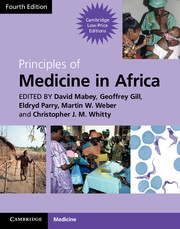Book contents
- Frontmatter
- Contents
- Contributors
- Foreword
- Section 1 Health and disease
- Section 2 Mother and child health
- Section 3 Infection: general principles
- Section 4 Major common infections
- Section 5 Bacterial infections
- Section 6 Viral Infections
- Section 7 Protozoal infections
- Section 8 Helminth infections
- Section 9 Fungal infections
- Section 10 Non-communicable diseases
- 56 Chronic and non-communicable disease in Africa
- 57 Chronic non-communicable disease in health care
- 58 Diabetes mellitus
- 59 Hypertension
- 60 Stroke
- 61 Epilepsy
- 62 Mental health
- 63 Asthma, chronic obstructive pulmonary disease (COPD) and exposure to indoor air pollution
- 64 The disabled patient
- Section 11 Diseases of body systems
- Section 12 Cancer and Palliative Care
- Section 13 Venoms and Poisons
- Index
- References
62 - Mental health
from Section 10 - Non-communicable diseases
Published online by Cambridge University Press: 05 March 2013
- Frontmatter
- Contents
- Contributors
- Foreword
- Section 1 Health and disease
- Section 2 Mother and child health
- Section 3 Infection: general principles
- Section 4 Major common infections
- Section 5 Bacterial infections
- Section 6 Viral Infections
- Section 7 Protozoal infections
- Section 8 Helminth infections
- Section 9 Fungal infections
- Section 10 Non-communicable diseases
- 56 Chronic and non-communicable disease in Africa
- 57 Chronic non-communicable disease in health care
- 58 Diabetes mellitus
- 59 Hypertension
- 60 Stroke
- 61 Epilepsy
- 62 Mental health
- 63 Asthma, chronic obstructive pulmonary disease (COPD) and exposure to indoor air pollution
- 64 The disabled patient
- Section 11 Diseases of body systems
- Section 12 Cancer and Palliative Care
- Section 13 Venoms and Poisons
- Index
- References
Summary
Mental illnesses are common. They occur in people of all ages, and can be found in every culture and racial group. Even though the form in which disorders manifest may be different across cultures and social–cultural differences may affect outcomes significantly, there is a general consensus that the major categories of mental disorders are present among humans wherever they happen to reside. These disorders include unipolar depression, bipolar affective disorder, schizophrenia, alcohol and drug use disorders, post-traumatic disorder, panic disorder, Alzheimer's disease and other dementias and primary insomnia. The prevalence of mental disorders is generally higher than that of any other class of chronic condition. However, the burden attributable to mental disorders results not only from their high prevalence, but also from the relatively early age of the onset of the more common types, and the tendency of many mental disorders to be chronic or recurrent. For example, the median age of onset for anxiety disorders is early teenage, and many affected individuals will go on to develop other types of mental disorder in adulthood.
Among persons seeking help in primary care or general health care settings, the proportion with mental disorders can be as high as 25 per cent (Ustun and Sartorius, 1995). These persons may be seeking care for physical conditions that are occurring along with the mental health problems or that are in fact resulting from the mental health problems. Mental disorders are also highly prevalent in the community. A number of large-scale community surveys have shown that between 25 and 50 per cent of adults will develop one mental disorder or another in their lifetime. In a 12-month period, between 1 in 10 and 1 in 5 adults will have significant levels of symptoms sufficient for a categorical diagnosis (Demyttenaere et al., 2004). The estimates reported from different studies tend to vary as a result of differences in the mode of ascertainment, the diagnostic categories covered and the age groups covered. There is also variability between countries. For example, the largest mental health survey ever conducted, the World Mental Health Surveys, report rates of 12-month disorder that vary between 4.7 per cent in Nigeria and 26.3 per cent in the USA (Demyttenaere et al., 2004). Whether this reflects the performance of the assessment tools, the reporting styles of people from different cultural backgrounds or a true difference in propensity to develop mental disorders is still unknown. The likelihood is that some or all of these factors are involved. Irrespective of where they are conducted, it is a common observation that prevalence rates in the general adult population typically under-estimate projected lifetime risk, so that more people are indeed likely to develop mental disorders in their lifetime than cross-sectional estimates suggest.
- Type
- Chapter
- Information
- Principles of Medicine in Africa , pp. 543 - 565Publisher: Cambridge University PressPrint publication year: 2013



